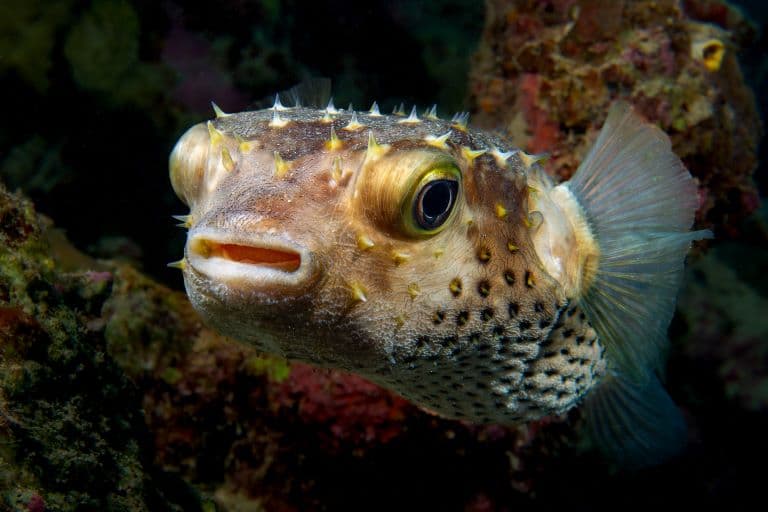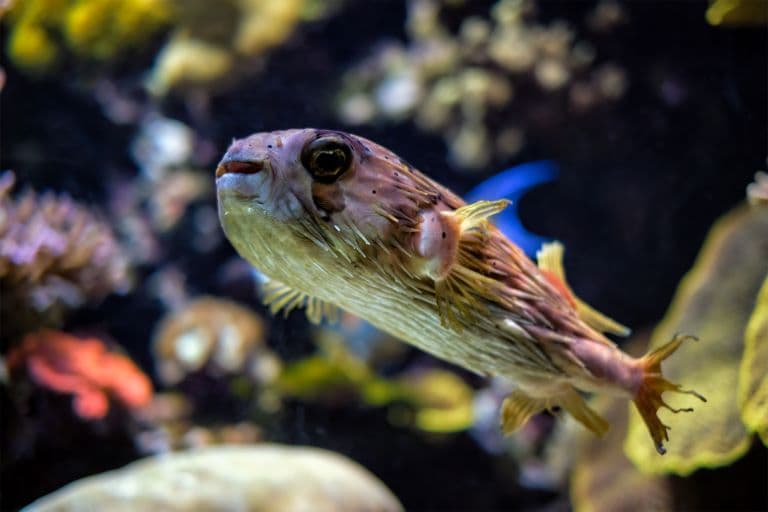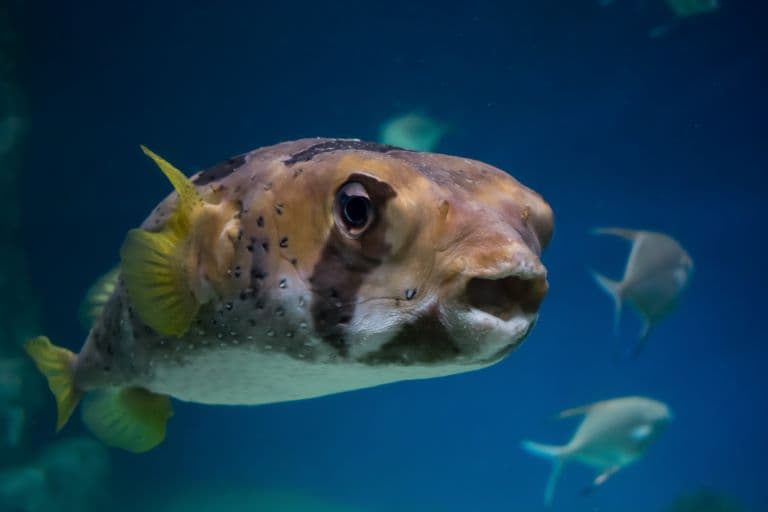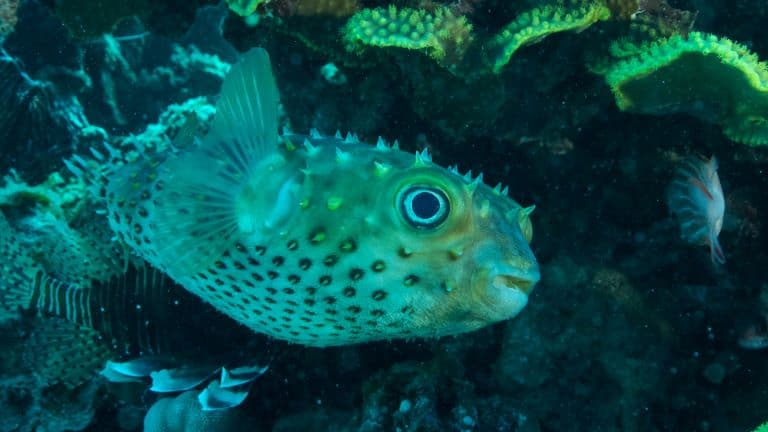Porcupinefish Profile
Tropical reefs are some of the most biodiverse and pristine ecosystems left on Earth. They’re lined with living rock: corals, built up in layers for thousands, sometimes hundreds of thousands of years, and dotted with the most alien creatures imaginable.
But this is still a hostile environment. Innumerable fish species feed on these aliens, and predators that are larger still feed on them in turn. So, unless you’re a whale shark, there’s always a bigger fish. Defences abound: spines, toxins and camouflage are common. And one line of fish specialises in all three.
Porcupine fish aren’t fast, but they’re no easy target, either.

Porcupinefish Facts Overview
| Habitat: | Reefs, tropical and subtropical marine waters |
| Location: | Worldwide |
| Lifespan: | At least 10 years in captivity |
| Size: | Up to a metre (3 ft) long in large species, usually under 30cm (1 ft) |
| Weight: | Up to around 3kg. |
| Colour: | Usually mottled browns, greys and greens |
| Diet: | Crustaceans, shellfish, urchins |
| Predators: | Wahoo, dolphinfishes, some sharks |
| Top Speed: | Slow |
| No. of Species: | At least 19 |
| Conservation Status: | All are Least Concern or Data Deficient (IUCN) |
Porcupinefish are very much like their better-known pufferfish relatives, but there are a few differences. They have long spines, and beaks, and can inflate themselves with either air or water, which looks very funny unless you’re a hapless lemon shark who mistakenly tried to swallow one.
Despite being relatively small and very slow-moving, not many animals are equipped to deal with these fishes, and so, for the most part, they’re doing rather well.
Interesting Porcupinefish Facts
1. Puffer vs Porcupine
Porcupinefish are members of the Tetraodontiformes order which contains the almost indistinguishable family Tetraodontidae, or the puffer fish. But porcupinefish themselves are from a sister family, the Diodontidae, and are therefore closely related but distinctly different.
This porcupinefish family is home to somewhere around 20 species of bony fish, and at first glance, they look just like their puffer siblings.
Both have spines that are adapted from scales on their bodies, both are a strange, boxy shape and both spend a lot of time around tropical reef environments. But there are some differences.
The spines of porcupinefish are longer than those of the puffer. Generally, the puffer’s spines can’t be seen until it inflates, and some have none at all. Porcupinefish wear their spines with pride, visible immediately, regardless of how bloated they’re feeling.
This extra spiny defence also gives them a behavioural difference: porcupinefish are a lot less likely to flee into a crevice at the first sight of danger, relying on their defence to make their point. That said, they are still shy and prefer to be left alone.
Note: One species, Diodon hystrix, is commonly referred to as the porcupinefish, which can confuse matters a bit, but as a member of the family Diodontidae, it will be a little disappointed to hear it’s just a porcupinefish and would do better to be called the spot-fin, or spotted porcupinefish. 1

2. They have teeth
The family name, Diodontidae, refers to the fused teeth on the jaw of these fishes, forming a single, beak-like structure, which they use to crunch through hard-shelled prey.
Crustaceans are a popular snack for porcupinefish but molluscs and urchins are also on the menu.
Like pufferfish, these are often nocturnal hunters and prefer to crunch about on slow-moving prey in the reef at night.
3. They have good nocturnal vision
The huge and shiny eyes you see on the front end of what looks essentially like a handheld vacuum cleaner are there for good reason. These are shallow-water, coastal feeders, and so they have access to light from above the ocean, even at night.
Lage and well-developed eyeballs give them pretty good nocturnal vision, which makes them effective predators during periods when a lot of their own predators will be unable to spot them. 2

4. They’re kinda cute
These eyes give the little fish a certain plushie quality and this can only be exaggerated when they’re startled, as when faced with a threat, they gulp in plenty of water, making themselves almost spherical.
When fully inflated they look like a ball of cactus fruit with big, defiant eyes peering out from amid the spines.
But before they reach maturity they’re even cuter. Eggs and sperm are released into the open ocean and within a week of fertilisation, mini porcupinefish hatch. Within about a week after that, they’re already able to blow up like a balloon, despite being around 5cm long.
The range of their habitats condenses as they age and find their way to the reef, and their shape and colour change, too. This is why until someone put the groundwork in to identify what was going on, there were over 75 species listed, most of which were just various life stages of other known species.
Despite being adorable, as you’d imagine, the spines make them hard to eat, but there are animals who might try anyway, so the porcupinefish, much like their more infamous cousins, have a second line of defence. 3

5. They’re also poisonous
Porcupinefish contain a similar toxin to the puffers and secrete toxins into their skin, too. This doesn’t stop people from eating them, but does rear its head on occasion when these toxins are missed in the preparation of the fish.
In Papua New Guinea, for example, a case emerged of an entire family becoming very sick within an hour of eating porcupinefish, some members even experiencing paralysis and requiring ventilation, two of whom died.
So this fish is no slouch when it comes to self-defence, but it is the spines after which they’re named that are most obvious as a deterrent.
6. They can kill sharks
The rearward-facing spines on the porcupinefish, coupled with its ability to increase in size more than two times, help protect it from larger predatory fish.
Porcupinefish have been known to kill sharks in this way, and at least one has been documented washing up ashore with a porcupinefish stuck in its mouth. 4 5
7. They get stuck in nets
Unfortunately, being spiny can work against you when your home is full of fishing nets, and porcupinefish of many species are commonly brought up by the fishing industry as bycatch.
These slow, weak-swimming fish have no way to escape capture when this happens, and so some populations are starting to notice a decline.
Still, for now, all listed species are not of much concern to the IUCN’s red list. 6
Porcupinefish Fact-File Summary
Scientific Classification
| Kingdom: | Animalia |
| Phylum: | Chordata |
| Class: | Actinopterygii |
| Order: | Tetraodontiformes |
| Family: | Diodontidae |
Fact Sources & References
- “Pufferfish & Porcupinefish”, United Parks & Resorts.
- “Actinopterygii ray-finned fishes”, Animal Diversity Web.
- Tennessee Aquarium (2022), “Our baby Long-spine Porcupinefish are totes adorbs!”, YouTube.
- A J Trevett (1997), “Tetrodotoxic poisoning from ingestion of a porcupine fish (Diodon hystrix) in Papua New Guinea: nerve conduction studies”, Publication.
- Earth Touch News (2017), “And this is why you shouldn’t swallow a porcupinefish”, Earth Touch Net Network.
- (2021), “Sea Wonder: Spotted Porcupinefish”, National Marine Sanctuary Foundation.
